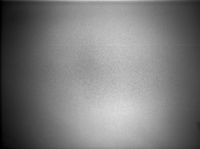Flat field
In CCD astroimaging a flat field (sometimes called a flat image) is an image taken in order to compensate for variances in light sensitivity across the CCD chip. If a CCD sensor is illuminated by a perfectly flat light source, that is that every part of the CCD surface is illuminated by exactly the same amount of light, the number of photons counted by each cell in the CCD will be different. In pretty picture imaging this can cause variations in brightness across the image. In scientific imaging this can introduce significant instrumentation error[1][2].
To compensate for this astronomers take a flat field image. This image is taken by pointing the optical system at a perfectly flat light source and allowing the CCD to be exposed for a period of time. This creates an image that shows not only the variance across the CCD but also any variance caused by the optical system such as dust or vignetting[1][2]. This image is then saved and used to correct any subsequent application images by dividing the application image by the flat field image</ref>[3].
Contents |
Types of Flat Field Images
There are several methods of creating a flat field image, each one has advantages and disadvantages and astronomers will often use a combination of methods in order to create a good flat field.
Dome Flats
As the name suggests, a dome flat is taken in the observatory (which is often covered with a dome). With this type of flat, a screen that is slightly larger than the aperture of the telescope is mounted somewhere in the observatory (usually on the dome) where it is evenly illuminated by artificial lights. The telescope is pointed at the screen and the flat image taken [1]. The advantage of a dome flat is that it can be taken at any time, even during the day. This means that valuable on-sky time isn't used for non-target imaging. The primary disadvantage of the dome flat is that it is often itself not flat due to variances in the lighting used and variances in the screen itself[1]. Also without special thought to the paint used on the screen, the screen may also not be truly white and thus not flat in certain filters[4].
Twilight Flats
There is a point in the sky about 20° from the zenith opposite the Sun right at sunset that is basically flat[1]. Since this point in the day is called twilight, this makes a twilight flat. The advantage to this type of flat is that it is readily available as all one has to do is wait till the appropriate time, point the telescope at the appropriate point in the sky and take the flat image. The disadvantage of this technique is that the point in time where this point in the sky is flat is limited to periods where the Sun is between 90° and 100° from the zenith[5]. This translates into a period of time of about 40 minutes each night and it is possible to miss this window while setting up for an evening's observing run.
Sky Flats
It is also possible to use the night sky itself as a flat field. The difficulty here is that there are things visible in the night sky such as stars that get in the way of making a sky flat. The way a sky flat is made is a point in the sky with few stars is selected. The telescope is pointed at this area, the tracking turned off (so the stars drift) and the flat image exposed. This is done many times. The resulting images are combined using a mode statistic which removes the star trails[1]. The advantage of this type of flat is that the colour is always correct. The night sky is always the colour of the night sky and thus in all filters will show the correct colour. The disadvantages are that even a mode statistic may not remove all the stars, making the image non-flat and that taking a series of sky flats takes time away from on-target imaging.
References
- ↑ 1.0 1.1 1.2 1.3 1.4 1.5 Birney, D.S., Gonzalez, G., Oesper, D., 2008, Observational Astronomy 2nd ed., Cambridge University Press, Cambridge, p173
- ↑ 2.0 2.1 Howell, S.B., 2010, Handbook of CCD Astronomy, 2nd ed. Cambridge University Press, Cambridge, p67
- ↑ Howell, S.B., 2010, Handbook of CCD Astronomy, 2nd ed. Cambridge University Press, Cambridge, p82
- ↑ Massey, P. and Jacoby, G.H., 1992, ASPC 23, p240
- ↑ Chromey, F.R. and Hasselbacher, D.A., 1996, PASP 108, p 994
